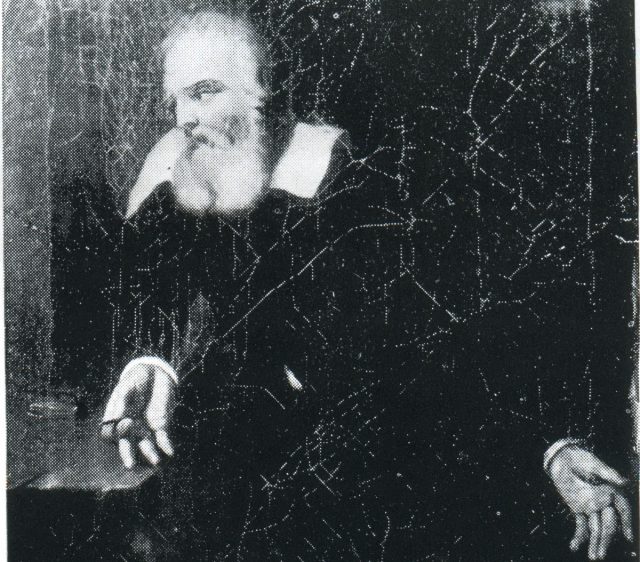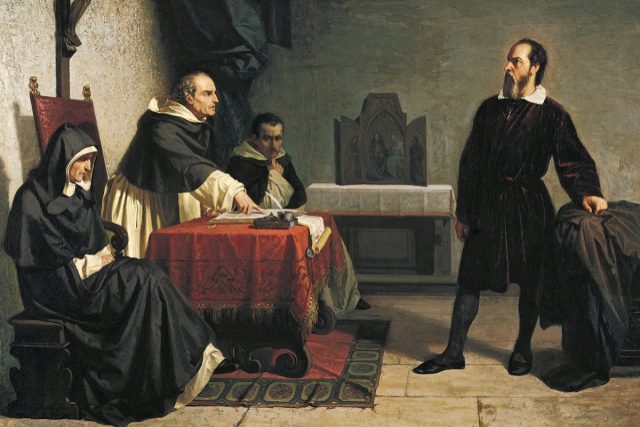Galileo Galilei famously stood trial for suspicion of heresy for his insistence—based on astronomical observations through his telescopes—that the Copernican model of the solar system was correct. The Earth revolved around the Sun, not the other way around, contrary to the Catholic Church's teachings at the time. He was never formally charged with heresy, but he was forced to recant his stance. Legend has it that after he did so, he muttered, "E pur si muove" ("And yet it moves"), meaning the Earth.
As with many such legends, it's probably too good to be true. "It would have been crazy for Galileo to say that in front of the Inquisitor," astrophysicist Mario Livio told Ars. Livio is the author of a new biography of the famous scientist, Galileo and the Science Deniers, and while researching the book, he found himself captivated by the longstanding debate about whether or not Galileo really spoke those words. It resulted in a separate academic paper about his findings.
The earliest biography of Galileo was written by his protege, Vincenzo Viviana in 1655-1656, with no mention of the phrase. According to Livio, the first mention in print is in a single paragraph in the 1757 book, The Italian Library, by Giuseppe Baretti, written over 100 years after Galileo's death. That would point to the story being a myth. But then a science historian named Antonio Favaro spent four decades studying Galileo's life and work, publishing a massive tome, The Works of Galileo Galilei. In 1911, he also published several articles detailing his efforts to determine the origin of the famous phrase.

That year, Favaro received a letter from a man in Belgium named Jules Van Belle, claiming to own a painting, circa 1643—shortly after Galileo's death in 1642— that depicted Galileo in prison, holding a nail in his right hand, having traced the Earth moving around the Sun. Written underneath was the famous motto. The painting was attributed to a Spanish painter named Bartolomé Esteban Murillo, and Van Belle thought it may have once belonged to an army commander named Ottavio Piccolomini, brother of the Archbishop of Siena. Galileo served the first six months of his house arrest at the archbishop's home.
That raised the possibility that Galileo had said those words, just not in front of the Inquisitor. Yet the painting was never examined by any independent art historians. When Livio decide to follow up on Favaro's work, over a century later, he found that nobody knew the current location of the Murillo painting. He consulted with four art experts specializing in Murillo's art, and all determined, based on photographs of the canvas, that it was not the Spanish artist's work.
After about a year hunting down various clues, Livio finally rediscovered Van Belle's painting. It had been sold to a private collector in 2007 by one of Van Belle's descendants. The auction house had dated the painting to the 19th century. So it is still far more likely that the famous phrase is just a legend that emerged sometime in the mid-18th century. But no final determination can be made unless the new owner agrees to let the painting be examined by art historians.
Nonetheless, "Even if Galileo never spoke those words, they have some relevance for our current troubled times, when even provable facts are under attack by science deniers," Livio recently wrote at Scientific American. "Galileo's legendary intellectual defiance—'in spite of what you believe, these are the facts'—becomes more important than ever." Ars sat down with Livio to learn more.

Ars: Perhaps Galileo never actually said "And yet it moves." But one of the most famous genuine quotes attributed to Galileo is this: "The book of Nature is written in the language of mathematics."
Livio: That was one of his incredible intuitions. Today, this is so natural to us. We still don't exactly understand it, but it's very natural that all the laws of physics are written as mathematical expressions or equations. But in his time, those laws were not written in any way. So how did he get this intuition that it is all written in the language of mathematics? To me, this is absolutely incredible that he thought about that. In fact, he formulated the very first laws of physics, with the slight exception of Archimedes maybe.
Ars Technica: Galileo is one of the most famous scientists in history and there have been so many books published about his life and work. What led you to write your own take?
Mario Livio: One reason is that all the existing biographies of Galileo, at least the serious biographies, were written mostly by science historians or science writers. None was written by an active researcher in astronomy or astrophysics. So I did think that I can perhaps put his discoveries in the context of what we know today. A second reason is that the very best biographies that exist are not that accessible for a general audience. They are scholarly biographies. So my goal was to write a somewhat shorter, more accessible, focused biography, but I did my best to still keep it entirely accurate.
Finally, I always knew this, but it just struck me even more so recently, that at the end of the day, Galileo was fighting science deniers, and we are unfortunately encountering a rampant science denial today. So I thought that this would be an important book to write. A fight that Galileo fought already 400 years ago, and truly, eventually won, it seems we somehow need to fight again.
Ars: Galileo is still a powerful symbol of intellectual freedom (scientific or otherwise). Why has Galileo captured our imaginations for so long?
Livio: There are many reasons for that. Galileo, by writing the Dialogue on the Two Chief World Systems, attracted a lot of attention. He was perhaps the best known scientist in Europe, because of his discoveries in astronomy. So his book attracted the wrath of the Inquisition and the Pope, and he was put on trial for this and was humiliated and suspected of heresy and put on house arrest for eight and a half years. This is pretty incredible. We are now in lockdown for what, a couple of months, and we're going crazy.
So he became the symbol for the fight for intellectual freedom. It was not, as sometimes it is portrayed, the fight between science and religion. Galileo was a religious person, like everybody else at that time. All his point was that the Bible is not a science book, and we shouldn't therefore interpret literally what is said there as if these are scientific facts. "The Bible was written for our salvation," he said, "Not as a science book."
"His tongue could be sharp, and his pen even sharper."
If there is an apparent conflict between a literal interpretation of the text in scripture and what experiments or observations tell us, then it means that we didn't understand and we need to change the interpretation. As long as the conclusions of science concerning physical reality are accepted, with no intervention of religious beliefs and no denouncing of provable facts, no conflict between the two realms can exist.
It had also to do with his personal characteristics, of which stubbornness was a chief one, as well as a high degree of self-righteousness.Read More – Source
[contf] [contfnew] 
arstechnica
[contfnewc] [contfnewc]







